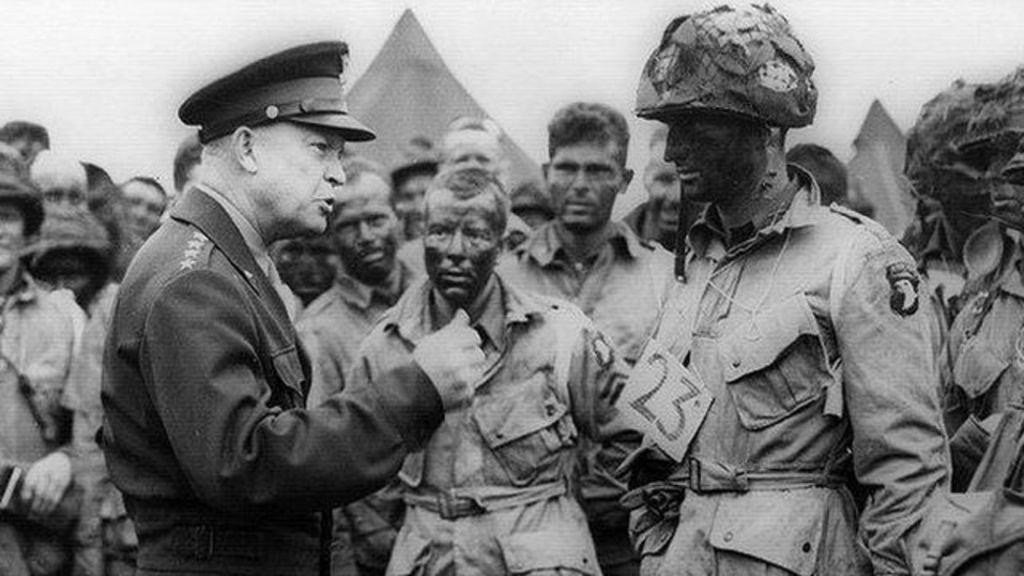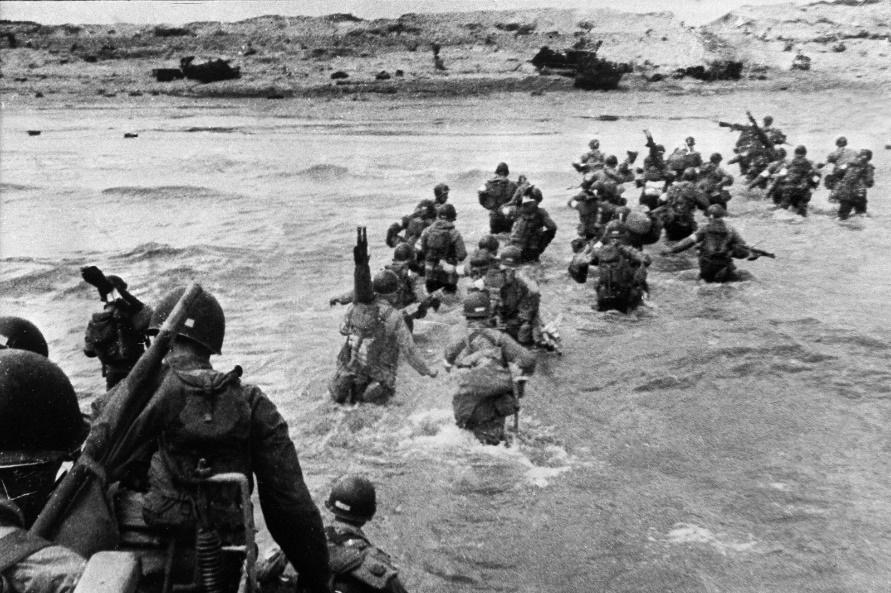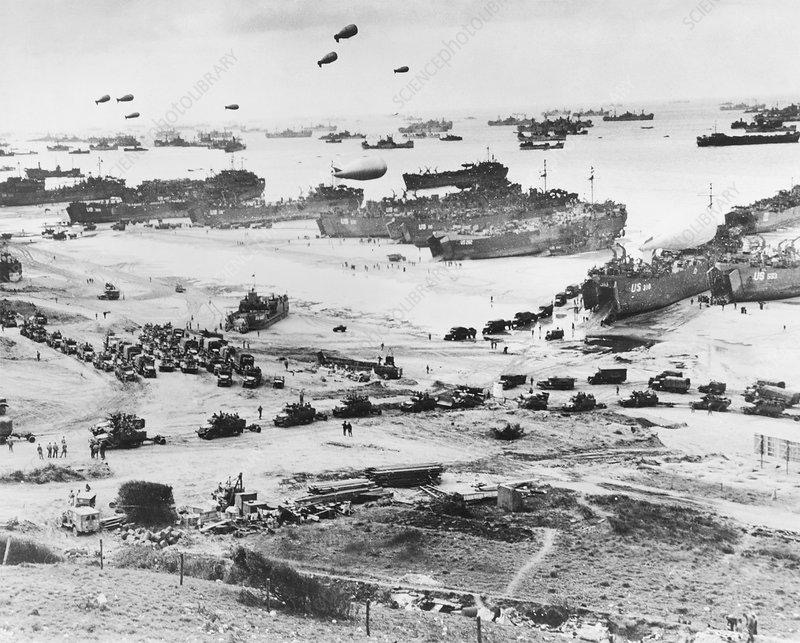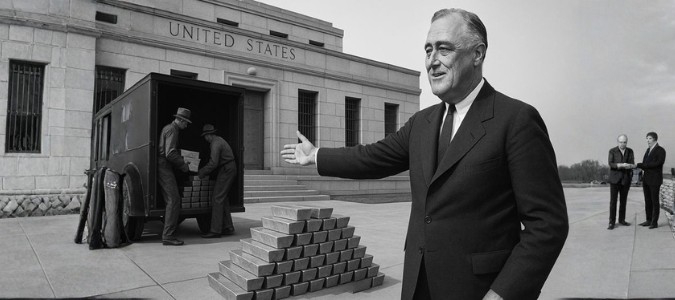
Posted June 06, 2024
By Byron King
King: D-Day, 80 Years On…
I’ll leave this solemn subject to Paradigm Press’s elder statesman and historian, Byron King, who wrote this engaging piece for the eightieth anniversary of the D-Day landings. My grandfather, John Zingaro, landed there that fateful day, while Homer King, the father of today’s author, flew ground attack missions overhead.
Read all about the Distinguished Flying Cross recipient’s “unintended air conditioning” below.
June 6, 1944: “L-Day”
Wait, what? L-Day? I suspect you thought that June 6, 1944, was D-Day, when U.S.-British-Canadian and other Allies invaded Normandy, France, eighty years ago today.
Yes, I know that the event is called D-Day, but for reasons I’ll explain in a moment, let’s go with the letter “L.” Bear with me…
Who Put the “D” in D-Day?
D-Day is a confusing label. There’s no correct explanation for the letter “D,” not now nor back on June 6, 1944.
In fact, in 1964, not quite twenty years after the end of the Second World War, an interviewer asked retired General and former U.S. President Dwight Eisenhower what the D meant. Ike tilted his head, thought for a moment, and wasn’t exactly sure, but it might represent “departure day” when troops kicked off toward the beaches.
 General Eisenhower and airborne troops, June 5, 1944. U.S. National Archives.
General Eisenhower and airborne troops, June 5, 1944. U.S. National Archives.
Ike’s answer might work if for no other reason than he was the Supreme Allied Commander of the entire operation. He should know, right?
Except with all respect to Ike, not everyone who hit the sand in France left their departure point on the same day. Many soldiers “departed” their bases days before the landing, and many sailors were moving into position weeks before June 6.
Other historians have opined that the D stood for decision-day or designated day, highlighting the calendar date when the landing craft moved shoreward. This is okay as informed speculation but not definitive. One old Army Staff College acquaintance once explained to me that the D was short for the word “day,” as if to say that the name of the operation was really Day-Day.
Let’s just grant that some people differ over the origin of the D-Day label and not bog down on the alphabetical point. More importantly, what occurred on June 6, 1944, was officially named Operation Overlord, the effort by Western powers in the Second World War to conduct an opposed landing in France, move ashore, and open a new front against German forces in occupied Europe.
This brings me back to calling the event “L-Day” because the landings were very much about logistics—mostly about logistics, truthfully.
Or, as Admiral Ernest King (no relation to your editor), Chief of Naval Operations for most of World War II, once quipped, “I don’t know what the hell this ‘logistics’ is, that [General George] Marshall is always talking about, but I want some of it.”
 CNO Admiral Ernest King (L) and General George Marshall (R), with General Henry Arnold (C), leave the White House after briefing President Roosevelt on June 6, 1944. U.S. National Archives.
CNO Admiral Ernest King (L) and General George Marshall (R), with General Henry Arnold (C), leave the White House after briefing President Roosevelt on June 6, 1944. U.S. National Archives.
The Meaning of June 6
Before we proceed further, pause for a few seconds and acknowledge that June 6, 1944, is truly an important date in U.S. history, as well as British, European, and even Soviet/Russian history. We’ll discuss it all in more depth, anon.
If you are so inclined, say a prayer and recall the bravery and sense of duty of everyone who crossed the line and went into France on that late spring day in 1944.
As an editorial point of privilege, I’ll mention my long-departed father, Homer King, who served as an Army combat pilot and flew ground attack missions during the June 6 landings. At one point, he piloted his heavily damaged P-47 fighter-bomber back to England, shot full of holes and leaking fuel. He landed and traded his bird in for another one without all the unintended air conditioning. Then he flew back to France. Much later, and somewhat to his surprise, he was called into the colonel’s office to receive a Distinguished Flying Cross.
 “For extraordinary achievement while participating in aerial flight.” U.S. Department of Defense.
“For extraordinary achievement while participating in aerial flight.” U.S. Department of Defense.
Depending on your age and origins, perhaps you, too, had a father or grandfather, uncle, etc. (and yes, more than a few women in uniform) who participated in the fight in Europe, 1941 – 45. Perhaps your relatives served in the Pacific Theater or some other front across the globe. Or they remained home in the U.S., possibly working at a defense plant. Or maybe it’s none of the above, and don’t worry 'cuz it’s all good. June 6 is your day, too.
Sadly, we live in an era when history is poorly taught in most schools and generally unappreciated across our culture. And if the cultural elite shuns any field of history, it’s military history. Just try to find a decent university program in military history at any U.S., Canadian, or British university (hint: good luck; you’ll be laughed out of the faculty lounge at most schools if you say you want to work in military history).
Meanwhile, if you want to be underwhelmed, walk through a college campus and ask 19- and 20-year-olds about World War II. To the extent that large numbers of people know much at all about June 6 and D-Day (or L-Day, as I’ll expand in a moment), it’s from movies like Saving Private Ryan (1998) or The Longest Day (1962); or perhaps the television series Band of Brothers (2001).
Okay, pilgrims… I’ll take some knowledge of the war over none at all. However, the problem with what you see in movies is that there are a lot of action scenes with soldiers hitting the beach or parachuting from airplanes. They land on the sand, rifle in hand, taking fire from enemy machine guns and artillery. They run up hills, blast away, toss hand grenades, capture pillboxes, and mow down the other side’s soldiers. As it all unfolds, one sees the Hollywood human side, with soldierly bonding, everyone looking out for their buddies, people being wounded and killed, and survivors living to fight another day.
Which is to say, learning “history” from watching movies is quite misleading. Because whatever they show on the screen, everything about fighting a war comes back to logistics.
Gimme the Fuel, Ammunition and Supplies
Consider this: How much gear do you think a typical soldier carries when he jumps out of an airplane or when the landing craft's ramp drops down? Forty pounds? 50? 75?
How much ammunition can anyone carry? How many rounds? How many hand grenades? What about troops who haul machine guns or mortars? Crew-served weapons weigh more than you think, as do the rounds they fire.
What about medical supplies? Or radios and batteries? Fresh water? And maybe some food? Plus, say, a small shovel, and maybe a rain poncho. And… you get the idea, right?
 American troops hit the beach on June 6, 1944. U.S. National Archives.
American troops hit the beach on June 6, 1944. U.S. National Archives.
Here’s the point. When Tom Hanks and his troops hit the beach in Saving Private Ryan and then humped through minefields and across the dunes, dodging bullets and shrapnel, every one of them had a combat-service life of about an hour, likely less. Because in a very short time span, they would have fired all their ammunition, tossed the grenades, used up the medical supplies, and (as the movie showed) the radio would be shot through.
And then what? Well… If it’s you in the dirt, hunkering undercover, you better have some of that “logistics” thing backing you up.
That is, after the first boats hit the beach and land troops, the next wave had better be right behind, hauling more troops to replace casualties and a lot of useful supplies, all staged for fast extraction and movement across open fields of fire. More rifle rounds, grenades, mortar shells, ammo belts for machine guns, medical supplies, and people to treat and evacuate the wounded.
Then comes engineering equipment like mine clearance devices and armored bulldozers to dig out firing positions. Plus, mobile field artillery and ammunition, along with gun crews and repair kits for when things break, because they always break.
And then, in other landing craft, not far behind that second or third wave, you require armored equipment like tanks and personnel carriers, hauling fuel (lots!), ammunition, communication gear, and much more. Indeed, after troops seize the beachhead, things begin to look like this:
 Landing ships deliver equipment and supplies to Normandy; cargo ships offshore. U.S. National Archives.
Landing ships deliver equipment and supplies to Normandy; cargo ships offshore. U.S. National Archives.
All of this—troops ashore, with weapons, ammo, gear, equipment, etc., following immediately—is but the tactical end of a massive, operational-strategic-level logistics effort.
Logistics, Logistics, and More Logistics
Of course, the invasion of June 6 was deeply planned, but the date itself was an accident of the calendar and weather. Immense levels of politics, planning, and war-related, economy-changing production went into the effort.
Where to begin? Well, consider how the Soviets were fighting Germany and her allies since the invasion in June 1941. After that, Soviet leader Joseph Stalin constantly demanded that Britain and the U.S. “open a second front” against Germany, considering that the Russians were taking casualties by the millions.
To give a feel for the scope of loss in the East, the Battle of Moscow in 1941 cost the Soviets over half a million troops killed. In 1942 - 43, the Soviets lost over 800,000 dead in the first year of the 900-day siege of Leningrad. In the same timeframe, 1942 – 43, Stalingrad cost the Soviets perhaps two million killed, while in 1943, the Kursk battle added another three-quarters of a million dead.
In November 1943, at the Tehran Conference, President Roosevelt and Prime Minister Churchill promised Stalin that the Western Allies would invade France in May 1944.
Of course, to accomplish that mission, the U.S. had to build entire fleets—over ten thousand—of cargo ships and landing craft, along with enough equipment to stage and wage a land war across northern Europe. This illustrates how logistics reflects a nation’s industrial power; stated another way, military power is the first derivative of a nation’s energy base and industrial system.
If you want ships, you need steel and machinery. But if you allocate steel and machinery to build ships, then the metal and equipment will not go into tanks or trucks. Plus, you need everything else that goes into ships, ranging from propellers to anchor chains, plus trained crews that take time to recruit and assemble.
Another U.S. strategic-logistical constraint was that the country was at war against Japan in the Pacific Theater. Admiral Nimitz and General MacArthur also wanted ships, aircraft, weapons, ammunition, fuel, medical supplies, trained personnel, and much else. While Russians died fighting Germans, Americans and British died, too, in ocean-spanning battles across the western and southwest Pacific.
And don’t neglect learning curves. For example, one early logistical disaster occurred in August 1942, with the battle for Guadalcanal, east of New Guinea. Basically, the Navy and Marines did a piss-poor job of loading cargo ships, such that critical materials were buried in the holds beneath less critical supplies.
Then, at Guadalcanal, Marines waded ashore, and supplies were slow to follow. In fact, most cargo never even made it to the beach because Japanese air attacks drove the ships away, leaving Marines stranded and scrounging for everything. By the second day, Marines were down to half-rations and soon had to sift through the sand to find random rounds of dropped ammunition.
Two years later, in 1944, the costly lessons of Guadalcanal were incorporated into the invasion of Normandy. The plan involved detailed mapping and intelligence gathering, overwhelming air supremacy, massive naval gunfire support, robust communications, and literally thousands of well-staged cargo ships offshore hauling fuel, ammunition, heavy weapons, medical support, and an encyclopedia of other warfighting kit.
Even then, Operation Overlord had problems. The weather in May was bad, so the invasion was postponed to June. Tides and moonlight dictated a short window of June 5 – 7, but much also depended on fickle weather. Even then, on June 6, winds and waves were severe enough to blow many airborne troops and seaborne landing craft away from their assigned targets, leading to deep levels of the proverbial “fog of war.”
And today, eighty years later, we remember it all, each in our own way and as best we can. The full story of just June 6 alone is a tale far too long to tell here, let alone to relate how the invasion unfolded in the following days, weeks, and months.
The immediate takeaway is to recall and honor the bravery of soldiers and sailors past and the brilliance of planners who put the operation together. That, and understanding that nothing big, complex, and important happens absent immense levels of thought and attention to detail; it could not happen back then and does not happen today. Which is to say, bone up on your logistics.
That’s all for now. And thank you for subscribing and reading.

Swamp, Brains, and the Game
Posted December 19, 2025
By Sean Ring

WTI…WTF?
Posted December 18, 2025
By Sean Ring

Icing The Green New Scam
Posted December 17, 2025
By Sean Ring

8 Things That Will Turbocharge The Gold Price
Posted December 16, 2025
By Jim Rickards

Can Miners Double Again?
Posted December 15, 2025
By Sean Ring
